

 Cryptogamie, Algologie
44 (4) - Pages 85-100
Cryptogamie, Algologie
44 (4) - Pages 85-100Algal biogeography in Hawai‘i has not been studied in detail for many species. The islands are home to swift-current deep-water channels separating suitable habitats. The ability of these channels to act as barriers to dispersal has been studied in several animal lineages and is assessed here using the widespread red alga Amansia glomerata C.Agardh. A variety of analytical techniques based on 129 mitochondrial COI barcoding sequences collected across c. 2500 km were used to assess the genetic diversity of A. glomerata in Hawai‘i. Haplotype network analyses demonstrated that the species is split into four main lineages which overlap in large parts of their range, yet there is insufficient support to recognize the lineages as separate species. Measures of haplotype diversity, nucleotide diversity, and neutrality tests suggest that at least three of these lineages have undergone recent population expansion. Biogeographic barriers were found to largely match those of marine animal groups in the archipelago. No evidence was found for distinct haplotypes or lineages between shallow and mesophotic reefs. A number of potential collection locations are suggested for the 1822 lectotype of the species, which was included in the molecular analyses. Potential scenarios leading to observed diversity patterns in the archipelago are presented. Amansia glomerata exhibits a high degree of haplotypic variation in Hawai‘i, suggesting it may exhibit vast molecular divergences across its broader range, which extends from Hawai‘i to southeastern Africa.
Tropical Pacific, haplotypes, lineages, lectotype, mesophotic